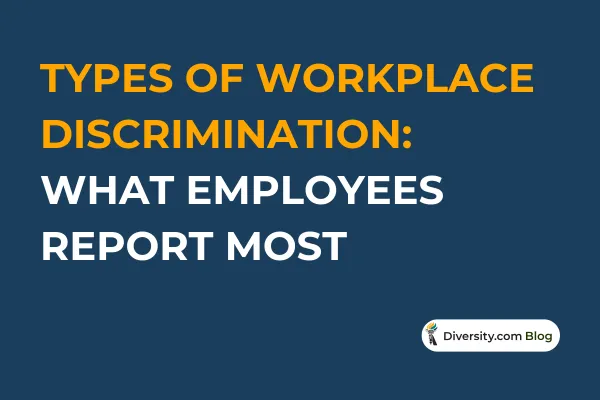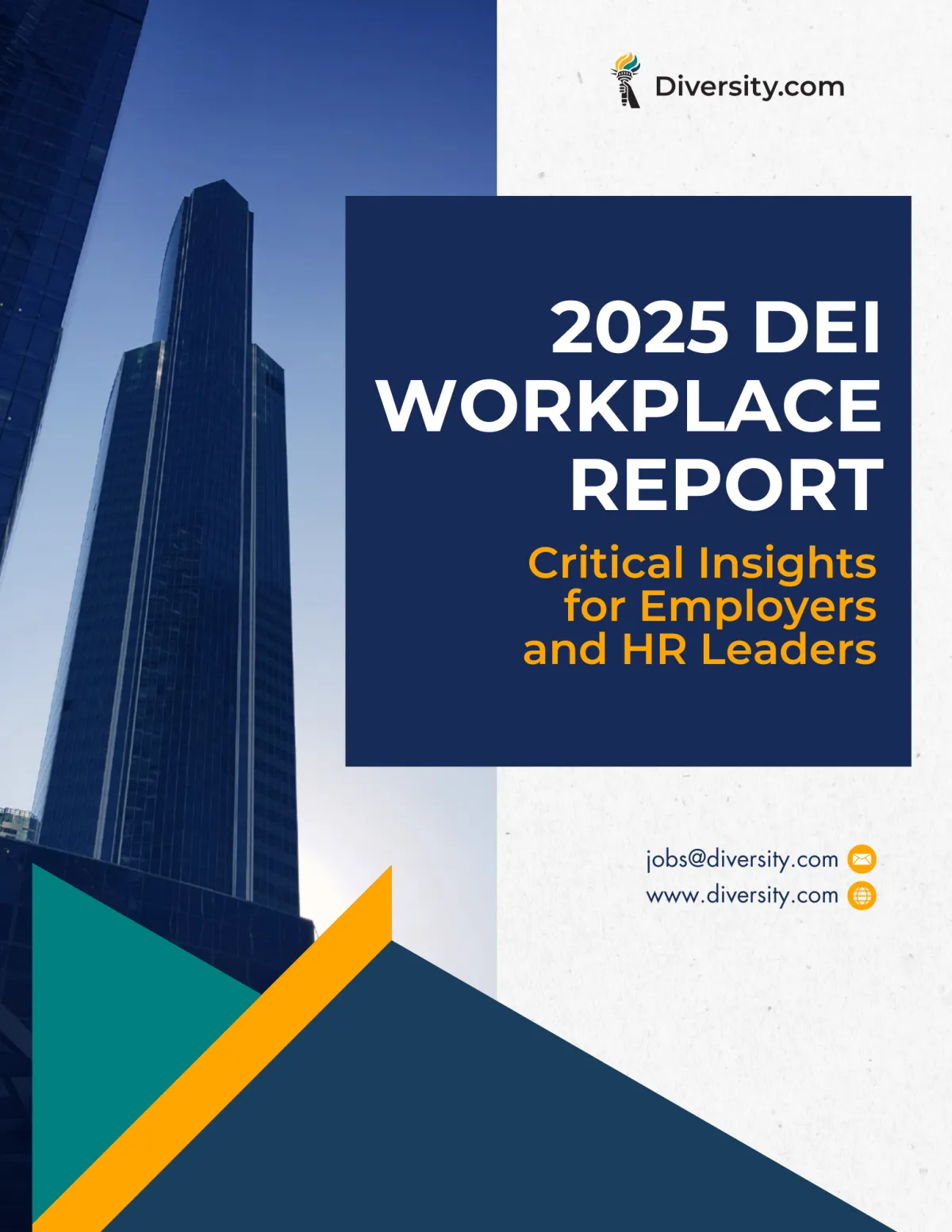
Types of Workplace Discrimination: What Employees Report Most
Discrimination doesn’t always arrive with intent.
Sometimes, it shows up in the form of passed-over promotions, biased assumptions, or a lack of accommodations. And while many leaders assume their DEI policies have things covered, employees say otherwise.
According to Diversity.com’s 2025 Workplace Discrimination Report, the most reported types of bias aren’t obscure edge cases. They’re persistent, familiar, and widely overlooked.
Let’s walk through the top forms of discrimination professionals still face—and what employers need to understand about their real-world impact.
The Most Reported Forms of Discrimination
In the 2025 report, employees most frequently cited discrimination based on:
Ethnicity
Age
Gender
While other factors like religion were also mentioned, the top three categories—ethnicity, age, and gender—stood out across industries.
These aren’t just checkboxes. They shape how employees are perceived, paid, and promoted.
Ethnicity Bias: Lower Promotion Odds, Higher Scrutiny
Professionals of color often face increased scrutiny, fewer advancement opportunities, and subtle (but compounding) exclusion from informal networks.
A study published in Harvard Business Review found that nonwhite employees are less likely to receive stretch assignments or leadership visibility, even when performance is equal (HBR, 2020).
This disparity doesn’t just affect morale. It directly impacts promotion velocity and career trajectory.
🔍 In Diversity.com's 2025 data, over 40% of those who reported bias cited ethnicity as a factor.
Ageism: A Quiet Career Stall
Age discrimination often flies under the radar. It can show up in the form of biased assumptions about tech skills, learning agility, or cultural “fit.”
The AARP reports that 78% of older workers have either seen or experienced age-based discrimination (AARP, 2023). Once impacted, many struggle to recover earnings lost from being passed over or pushed out.
📉 Age bias is often linked to pay stagnation and reduced promotion opportunities.
Despite being unlawful under the Age Discrimination in Employment Act (ADEA), enforcement remains inconsistent.
Gender Discrimination: Still a Pay Problem
Gender bias continues to show up in compensation gaps, interrupted career paths, and glass-ceiling limitations.
Even with awareness campaigns and audits, women in the U.S. still earn roughly 82 cents for every dollar earned by men (U.S. Department of Labor, 2024).
In many workplaces, gender-based bias intersects with caregiving responsibilities and biased performance evaluations.
For pregnant employees, the 2023 Pregnant Workers Fairness Act added clarity, but enforcement and education are still lagging.
Legal Frameworks That Matter
Discrimination based on identity is prohibited under several major regulations, including:
Title VII of the Civil Rights Act: Protects against discrimination based on race, color, religion, sex, or national origin.
The Americans with Disabilities Act (ADA): Ensures reasonable accommodations for employees with disabilities.
The Age Discrimination in Employment Act (ADEA): Prohibits age-based bias for workers 40 and older.
PWFA (2023): Offers accommodation protections for pregnancy and related conditions.
Despite these frameworks, reporting remains low, and many employees still choose silence over formal complaints.
What Leaders Can Do Now
1. Train for subtle bias
Bias isn’t always overt. Make sure your training includes microaggressions, intersectionality, and retaliation.
2. Establish anonymous reporting
When reporting isn’t safe, silence becomes the norm. Anonymous channels can surface patterns earlier.
3. Audit outcomes, not just inputs
Hiring rates are just the start. Look at promotions, pay bands, performance ratings, and exit interview data.
4. Prioritize psychological safety
Teams can’t innovate when people are managing identity threats. Culture audits and skip-level check-ins help.
The Bottom Line
The most common forms of workplace discrimination aren’t hidden in obscure departments. They’re happening in plain sight—and employees are still paying the price.
Ethnicity, age, and gender remain the most frequently reported categories. But behind every data point is a story of lost momentum, unspoken frustration, or diminished trust.
See what professionals themselves are saying in the full 2025 Workplace Discrimination Report. And if you’re a leader, now is the time to revisit what equity looks like in practice—not just policy.
Build Inclusive, Equitable, and Safer Workplaces with Diversity.com
At Diversity.com, we help employers and job seekers connect through inclusive job postings, flexible job packages, and trusted DEI resources.
Whether you're improving your company’s workplace culture or exploring roles where your voice matters, we’re here to support you.
Looking for data to guide your strategy? Choose a report below:
Download the 2025 DEI Workplace Report – Gain insights into diversity, equity, and inclusion trends across multiple industries.
Download the 2025 Workplace Discrimination Report – Explore in-depth findings on bias, exclusion, and psychological safety in today’s workplace.
For Employers & HR Professionals:
✔ Choose a DEI Job Posting Package – Connect with underrepresented talent using flexible, targeted options.
✔ Access DEI Insights & Reports — Browse practical guides, data-backed articles, and expert wisdom to strengthen your inclusive hiring.
✔ Join Our LinkedIn Community — Collaborate with HR and DEI professionals on hiring trends and best practices.
For Job Seekers:
✔ Find Diversity and Inclusion Jobs — Discover meaningful roles at companies that champion equity and representation.
✔ Create a free job seeker account — Apply confidently for jobs with companies that believe in equity.
✔ Read Our Latest DEI Articles — Stay informed with expert-backed insights on workplace inclusion, safety, and growth.
Every hire and every voice helps shape the future of work.
Get started with Diversity.com.
Have questions? Reach out to our team. We're here to support you.
Related Articles
Generational Bias: Why the Youngest and Oldest Workers Face the Most Discrimination
Do Employees Feel Heard? What the Data Says About Belonging in 2025
Intersectionality at Work: Why Overlapping Identities Matter in DEI Strategy
When Will Diversity Affect the Workplace? What to Expect in 2025 and Beyond
Sources & References
AARP. (2023). Age Discrimination Still Common in U.S. Workplaces. https://www.aarp.org/work/age-discrimination/info-2023/older-workers-experience-bias.html
Harvard Business Review. (2020). Why Are There Still So Few Black Executives?. https://hbr.org/2020/08/why-are-there-still-so-few-black-executives
U.S. Department of Labor. (2024). The Gender Pay Gap. https://www.dol.gov/agencies/wb/data/gender-pay-gap
EEOC. (2024). Federal Laws Prohibiting Job Discrimination. https://www.eeoc.gov/statutes/laws-enforced-eeoc
Diversity.com. (2025). Workplace Discrimination Report.

